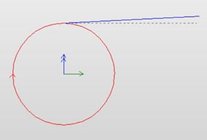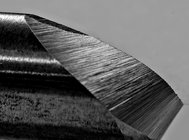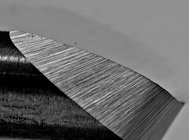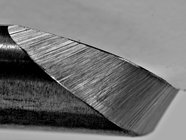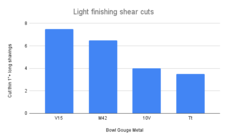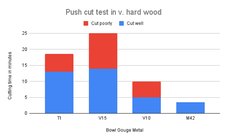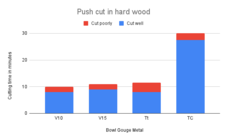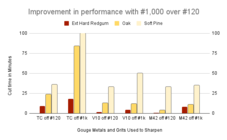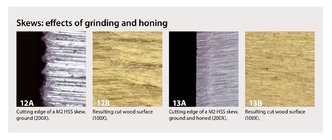@Neil S. Has a really good post about tungsten carbide bowl gouges. He gives good information on sharpening TC.
The durability of an edge is something that we can measure. Those measurements can be useful to others if we specify the criteria on which we made our judgement that a particular edge profile made form a particular metal composition had stopped cutting a particular material.
But sharpness is a far more subjective judgement. A lot of personal preferences go into making those judgements and they are not readily conveyed to others. Not least among those is the judgement on how much time and effort would be required to bring an edge backup to a preferred degree of sharpness balanced against how well (not how long) it is cutting for you at the time.
I sharpen many different types of cutting tools for different purposes; going from high-end Japanese hand forged kitchen knives using natural stones up into the #20-30k grit range, down to firewood splitting axes, and large one and two-person hand saws in between, to name just a few. I spend a lot of time looking at edges under magnification, but what is a useful level of sharpness on a tool for one purpose would be totally unproductive for other purposes. What I might judge to be sufficiently sharp may be very different to what you or others may decide.
When I'm turning the final cuts on punky piece of wood I prepare or reach for the 'sharpest' tool I have to do that. I know the preferred level of sharpness that I want for that purpose and its durability at a lower level of sharpness is of little interest at that stage of the job. However, for most of the time I'm turning I'm after durability. I want an edge that will get the bulk of the job done with the least number of trips to the grinder.
What then can I say that might be useful to other... in broad terms, the larger carbides in some of the 'exotic' woodturning tools we use provide more durable cutting edges, while others with finer carbides can take a finer edge (as seen under magnification) but usually don't hold their edge for so long.
The extreme end of that is good quality plain carbon steel like they use in razors, which can take the finest of edges, which is ideal for shaving, but is almost gone instantly if used to turn most woods.
At the other end is Tungsten Carbide that (in most grades) will never feel really sharp, but will cut 'satisfactorily' for longer than most of the other turning tool steels we use and particularly with the tougher woods.
In between we have steels like M42 that have a finer grain structure that take a beautifully sharp to the feel edge that is excellent for finishing cuts, but not quite as durable as some of the other HSSs.
M2 also takes a very fine edge, but is not as durable as M42
Among the more durable edge steels are Tantung and the vanadium steels. Of those a 15% vanadium is robust but is harder to put a fine edge on. A10% vanadium tool is a two-way bet, it seems to take a slightly finer edge but is not quite as durable as the 15% vanadium.
Much is made of the heat treatments used on the various steels. The bottom line there is it should be optimised for whichever steel it is being applied to, but the significant differences comes from the steel compositions.
The comparative cost of the tools and the abrasives we use to sharpen them are, of course, other factors that come into our judgments.
I've posted the following results of my testing elsewhere on the forum, so just added here without details. See how the 'sharpness' of the finer carbides in M42 does very well with fine finishing shear cuts but not so well in its durability with heavier push cuts. The Tt steel was for Tantung.

